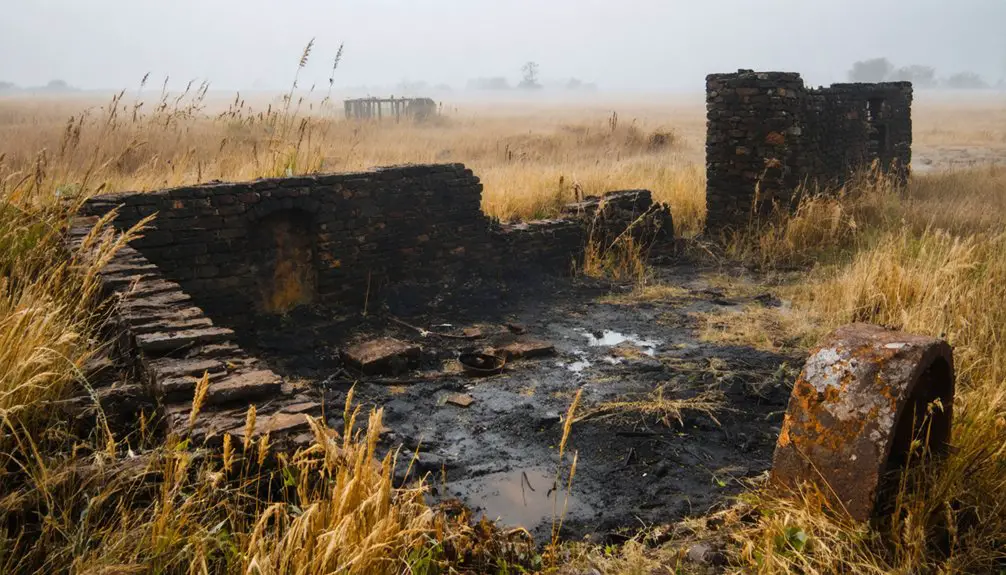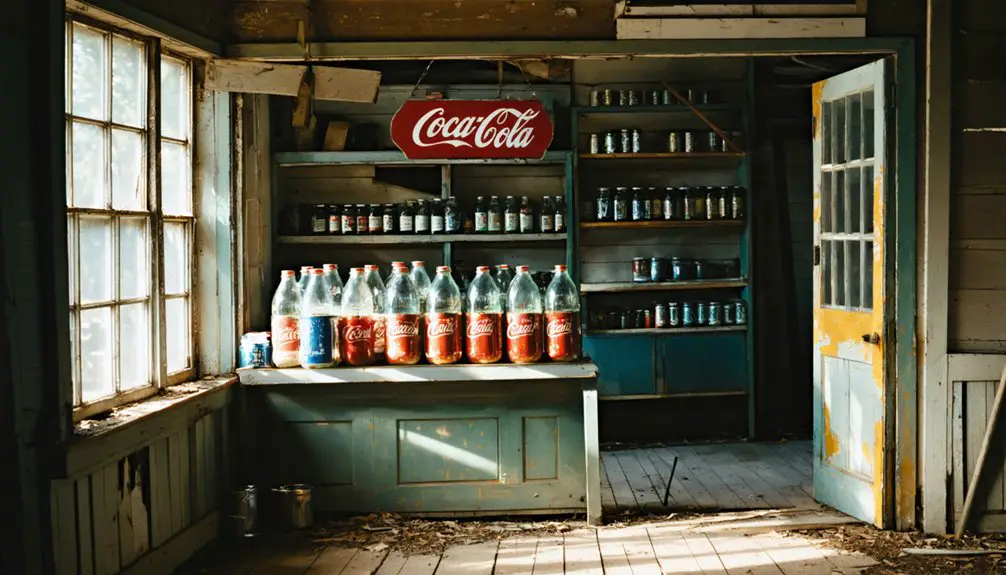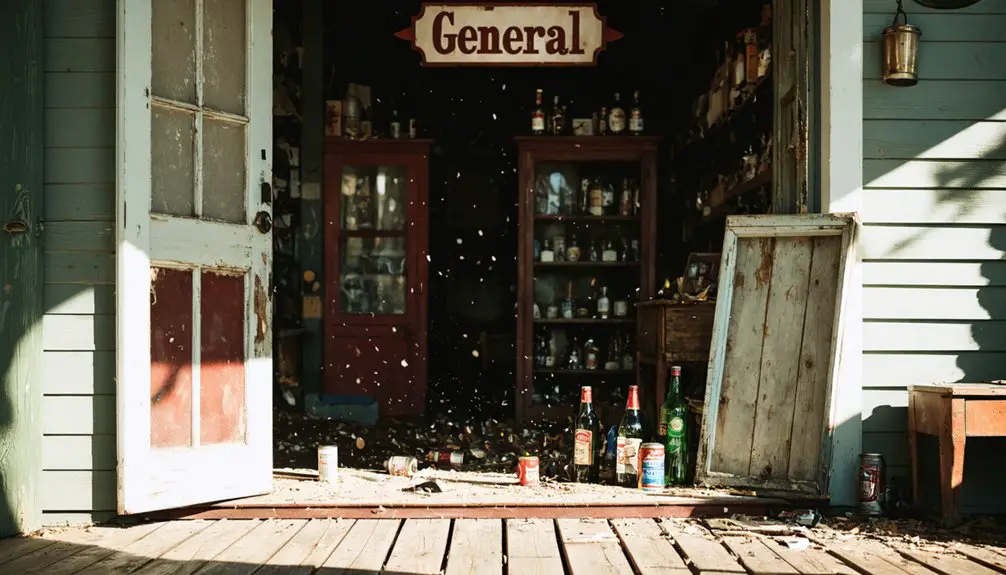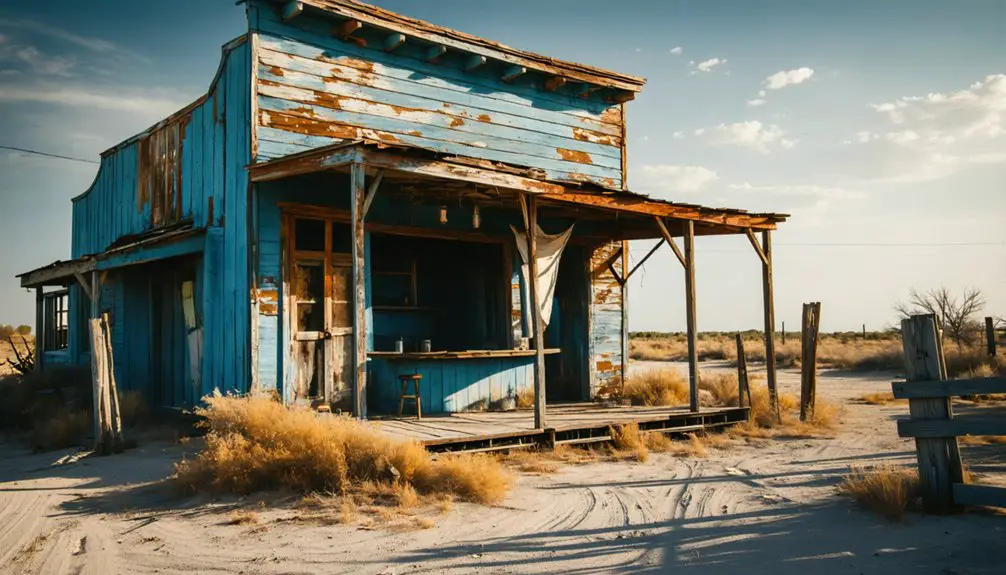You’ll find the original Cold Springs settlement, established in 1850, submerged beneath Lake Livingston’s waters today. This frontier town, first called Coonskin, served as San Jacinto County’s hub until 1915 when a devastating courthouse fire prompted relocation to higher ground. The new site became Coldspring (one word), while the original townsite slowly faded away. The old jail museum and historic district preserve fascinating tales of this transformed Texas community.
Key Takeaways
- Population declined from 750 in the 1960s to 569 by 1980, showing a significant downward trend in residents.
- The 1915 courthouse fire led to relocation and urban transformation, marking a pivotal change in the town’s development.
- Originally named Coonskin in 1847, the settlement evolved through several name changes before becoming modern-day Coldspring.
- The town’s economy shifted from timber dependence after the 1945 oilfield discovery, altering its industrial foundation.
- Historical structures, including the 1887 jail-turned-museum, preserve the town’s frontier legacy despite population decline.
The Evolution of Three Names: From Coonskin to Coldspring
While many Texas towns underwent name changes during their early development, few experienced the distinctive evolution seen in present-day Coldspring. Similar to how disambiguation pages clarify multiple locations sharing the same name, this town’s history showcases the need for distinct identities.
You’ll find its Coonskin origins tied to an 1847 trading post, followed by a brief stint as Firemen’s Hill. The Cold Springs significance emerged in 1850 when the town was formally platted into 14 blocks, drawing its name from the natural springs that attracted settlers.
As the community identity strengthened, postal confusion with another Texas town called Cold Springs prompted the final name change. In 1894, the Coldspring legalities were settled, consolidating the two-word spelling into one. The town’s growth continued with the construction of its first wooden courthouse in 1877, marking its importance as the county seat.
Each name change impact reflected the town’s transformation from a frontier trading post to an established county seat.
Natural Springs and Early Settlement Tales
You’ll find that natural springs played a defining role in Coldspring’s original settlement location, with pioneers strategically establishing their community near reliable water sources before 1850.
The springs’ cool, clear waters served both domestic needs and powered early industry, including gristmills and cotton gins that were essential to the area’s development. These natural water sources were part of Texas’ extensive network of major springs sites, with historians documenting at least 281 significant locations across the state.
When you explore the settlement’s early history, you’ll discover that these cypress-lined spring pits not only sustained life but also influenced the placement of important community structures like the Cold Springs School and Church, founded in 1889.
Springs Define Settlement Location
The natural springs of Cold Springs, Texas played a defining role in the settlement’s early development during the frontier era.
You’ll find that these springs’ significance shaped the entire community’s layout, as settlers strategically positioned their homesteads near this reliable water source. The springs offered year-round flow, making them invaluable in the semi-arid Texas landscape where seasonal water sources couldn’t be trusted.
Settlement patterns evolved around these life-giving waters, which provided everything early residents needed – drinking water, crop irrigation, and sustenance for livestock. Similar to the warm water springs at Boquillas, these waters served as a vital resource for the developing community. Visitors often encountered desert wildlife like armadillos and javelinas near the springs’ edges.
The springs’ location at the base of surrounding hills offered natural shelter, while the fertile soil in the spring-fed valley attracted farmers.
You’d have found the springs serving as a natural gathering point, where trading posts and community buildings eventually emerged, cementing Cold Springs’ position as a frontier hub.
Pioneer Water Source Stories
Pioneer stories paint a vivid picture of life centered around Cold Springs’ natural waters during the 1850s settlement period.
You’ll find that these springs weren’t just convenient – they were absolutely critical for pioneer survival in East Texas, where rainfall proved unpredictable and shallow wells couldn’t be trusted. Early settlers learned quickly about water conservation, establishing their homes and trading posts strategically around these reliable water sources.
You can trace the region’s development through the springs’ influence, from the Mexican land grants to Robert Rankin’s early colonists. The springs sparked intense competition between settlers and Native Americans, while also powering essential operations like flour mills and cotton gins. Like the famous Sutherland Springs resort in San Antonio, these waters drew visitors seeking their perceived healing properties.
Even after the town shifted to being called Coldspring, these waters remained the community’s lifeblood through the early 1900s.
Life in the Original Townsite
You’d find pioneer life in Cold Springs centered around the original wooden courthouse, where legal proceedings and community gatherings kept the townsite bustling with activity.
Social events like dances and quilting bees regularly brought townsfolk together in multi-purpose buildings, including the schoolhouse that served as both an educational facility and community center.
The town’s daily rhythm flowed between the courthouse square, trading posts, and post office (then called “Coonskin”), where residents conducted business and caught up on local news before the devastating 1915 fire changed everything.
The early education scene flourished with the establishment of the 1880 Male and Female Institute, providing advanced learning opportunities for the community’s youth.
Dedicated residents worked to preserve local heritage through donations and community support, ensuring their town’s history would be documented for future generations.
Daily Pioneer Activities
Life in Cold Springs’ original townsite centered around a bustling mix of agricultural and commercial activities that defined the daily routines of its pioneer residents.
You’d find locals tending to their subsistence farms, trading at general stores, or working in the thriving lumber industry. Pioneer chores included fetching water from natural springs and maintaining muddy streets through communal efforts. After the commissary opened in 1926, residents gained a vital new trading hub that enhanced local commerce.
Community gatherings often took place at the courthouse, where you’d witness everything from judicial proceedings to political meetings.
- Start your day at the courthouse square, where legal trials and civic meetings shaped local governance
- Trade your goods at local mercantile outlets, exchanging farming produce and timber
- Visit the Male and Female Institute or Mrs. India Grace’s school, where education flourished despite frontier challenges
Social Gathering Spots
The social fabric of Cold Springs’ original townsite revolved around distinct gathering spots that brought pioneers together in both formal and casual settings.
You’d find the town square bustling with activity, as buildings from the mid-1800s housed key meeting points where community interactions flourished until the courthouse fire of 1915. The courthouse area served as the heart of social events, while the old county jail, now converted to a museum, continues to draw people together through historical education and paranormal investigations. Many visitors return repeatedly after experiencing unexplained phenomena during ghost hunting events.
Today, you’ll discover modern venues like the Mason Jar Bar & Grill alongside traditional spaces like the Coldspring Community Center.
The center’s gardens, maintained by local master gardeners, provide a natural backdrop for celebrations, while venues like Isabella’s and Pearls In The Pines host contemporary gatherings that keep the town’s social spirit alive.
Courthouse Before The Fire
Standing prominently in Cold Springs’ original townsite, San Jacinto County’s first courthouse emerged as a two-story wooden frame structure in 1871, built by Fort Worth contractors Thomas and Werner.
Before its construction, you’d find judicial activities taking place at the Carnes Hotel, which served as a temporary courtroom for the growing county.
The courthouse significance extended beyond its role as a center of government, becoming the heart of civic life for 44 years until the devastating 1915 fire.
You’ll appreciate how this wooden landmark shaped the original townsite’s development.
- Served as the central hub for county administration and legal proceedings
- Established Cold Springs as a legitimate frontier town with proper judicial facilities
- Created a gathering point for residents handling government business and attending court sessions
The Great Fire and Town Relocation

When flames engulfed San Jacinto County’s wooden courthouse in 1915, the catastrophic fire triggered a pivotal transformation of Coldspring’s urban landscape.
You’ll find that this disaster prompted local leaders to reimagine their town planning strategy, relocating the county seat to higher ground just blocks away on land donated by forward-thinking residents.
The move wasn’t just about rebuilding – it revolutionized the community’s approach to fire safety.
While the original jail survived and stands today as a museum, the new townsite flourished between 1916 and 1923 with modern construction.
Some locals embraced the change creatively, like the homeowner who simply rotated his house to face the new courthouse square.
The relocation shaped Coldspring’s development pattern and created a more resilient infrastructure that you can still see today.
Historic Buildings and Landmarks
Preserved within Old Town Coldspring’s historic district, an impressive collection of mid-1850s buildings creates an authentic 19th-century atmosphere you won’t find anywhere else in San Jacinto County.
You’ll discover architectural styles that tell stories of Texas frontier life, including the iconic 1887 jail with its yellow-pink brick and iron-barred windows. Ghost stories and local lore surround these historic structures, particularly the infamous “Hanging Tree” near the old courthouse site.
- The Old Jail Museum showcases original cells, gallows, and local artifacts that’ll transport you back to frontier justice days.
- You’ll find relocated historic buildings from across the county, strategically placed around the original town square.
- Experience the preserved courthouse site, where paranormal investigations now reveal tales of the past’s darker moments.
Economic Shifts Through the Decades

You’ll find Cold Springs’ earliest economic foundations firmly rooted in agriculture, county government operations, and extensive lumber production through companies like Delta Land and Timber’s 1926 commissary and the Gibbs brothers’ Palmetto Lumber Company.
While the 1945 discovery of the Cold Springs oilfield marked a pivotal shift away from timber dependence, the town’s transformation accelerated with infrastructure improvements including Gulf States Utility’s 1936 power lines and the Rural Electrification Administration’s reach by 1940.
The population trends tell the story of these economic shifts, as you can trace the town’s peak of 750 residents in the early 1960s through its decline to 569 by 1980, despite the broader county experiencing growth from oil-related activities.
Early Industry Foundations
The foundations of Cold Springs’ early economy rested firmly on the lumber industry, which dominated local employment and commerce from the 1850s onward.
You’ll find that lumber operations served as the primary economic drivers, with significant developments like the Delta Land and Timber Company‘s commissary in 1926 marking the industry’s stronghold.
When Kurth interests from Lufkin acquired the sawmill in 1931, it demonstrated the ongoing evolution of local timber operations.
- The lumber industry remained resilient through the Great Depression, providing essential employment
- Delta Land and Timber Company’s 1926 commissary became a cornerstone of local commerce
- Timber operations sustained the community even as other sectors struggled to gain footing
Despite economic challenges, you’ll see that Cold Springs’ timber industry maintained its influence until the mid-20th century when new economic sectors emerged.
Modern Revenue Sources
As Cold Springs moved beyond its lumber-dominated past, dramatic economic shifts reshaped the town’s revenue landscape from the 1950s onward. A mid-century oil discovery briefly energized the local economy, but you’ll find this boom ultimately faded, leaving the community to seek alternative income sources.
Today, you’ll see ghost town tourism and heritage preservation efforts leading Cold Springs’ economic activities. Small-scale ventures showcase historic buildings and host local events, though limited lodging options constrain visitor growth.
The government sector, including county offices and public services, provides stable employment, while agriculture and forestry persist at reduced levels. Real estate faces challenges, with declining home values and high vacancy rates reflecting the town’s economic struggles.
Some residents have adapted through specialty farming and conservation programs to supplement their income.
Law Enforcement Legacy and Local Legends
Since its establishment as San Jacinto County’s seat in 1870, Cold Springs’ law enforcement legacy has been inextricably woven into the town’s identity through its historic infrastructure and folklore.
You’ll find this heritage preserved in the original county jail, now a museum on the National Register of Historic Places, and in tales of the infamous “Hanging Tree” that symbolizes frontier justice.
- The 1915 courthouse fire prompted relocation of law enforcement facilities, marking a pivotal shift in the town’s development.
- Sheriff Humpy Parker’s controversial tenure in the 1980s inspired “Terror on Highway 59” and left an indelible mark on local crime lore.
- The old jail museum, operational until 1980, stands as a reflection of the evolution of justice in this historic Texas town.
Tourism and Preservation Efforts

Building upon its law enforcement legacy, Cold Springs has transformed its historical sites into compelling tourist destinations that capture the imagination of visitors year-round.
You’ll discover a charming town square surrounded by repurposed historical buildings, where preservation initiatives maintain authentic connections to the past through guided tours and educational programs.
Your outdoor adventures await at Wolf Creek Park and Double Lake Recreation Area, where you’re free to hike, bike, and fish.
The town’s unique status as a fourth-iteration settlement adds intrigue to tourist engagement, especially during seasonal events and themed tours.
While exploring the San Jacinto County Courthouse and Jail, you’ll experience how this community of 819 residents balances modernization with historical conservation, creating a sustainable tourism economy that honors their heritage while embracing the future.
Remnants of the Original Settlement
Physical remnants of Cold Springs’ original settlement paint a vivid picture of pioneer life in East Texas. You’ll discover how settlement patterns formed around a crucial cold spring that drew Native Americans and early settlers to this location.
The Historic Heritage Center preserves the town’s material legacy, while Old Town Coldspring showcases surviving wooden frame buildings that reflect early regional architecture. After the 1915 courthouse fire, historic preservation efforts included relocating original structures near the new 1918 courthouse.
- Explore the rebuilt 1918 courthouse and replica 1870s general store in Old Town
- Walk Cold Springs Road, which follows original pioneer transportation routes
- Visit the Camilla Hotel and surrounding historic district to experience authentic East Texas construction methods
Impact on East Texas History
Throughout its rich history, Coldspring has profoundly shaped East Texas‘s development as the enduring county seat of San Jacinto County since 1870.
You’ll find its influence deeply woven into the region’s economic and social fabric, from the bustling lumber industry that drove employment to the establishment of essential financial institutions in 1907.
The town’s cultural legends, including the famous Hanging Tree story, have become integral pieces of East Texas folklore.
When you explore the area’s evolution from Coonskin to Coldspring, you’ll discover how agricultural practices and natural resources shaped local development.
Even after the 1915 courthouse fire forced relocation, the community’s resilience demonstrated the adaptability that characterized East Texas settlements, while preserved structures like the old county jail continue to tell the region’s compelling story.
Frequently Asked Questions
What Happened to the Descendants of Joseph Graves, Who Named Cold Spring?
You’ll find that most Graves family descendants dispersed throughout Texas, leaving behind their town legacy. While some likely stayed in ranching, there’s limited concrete evidence of their specific paths.
Are There Guided Tours Available to Explore the Original Townsite?
While 90% of Texas ghost towns lack formal tours, you won’t find commercial guided exploration of the original townsite. You’ll need to arrange private access through local historical societies for significant locations.
How Deep Were the Natural Springs That Gave the Town Its Name?
You’ll find the spring depth likely ranged from 12 to 25 feet, based on historical records of similar Texas Hill Country springs emerging from limestone aquifers, though exact measurements weren’t documented.
Did Any Famous Outlaws Ever Visit or Get Arrested in Cold Spring?
You won’t find any confirmed outlaw sightings in Cold Spring. Even during Texas’s wild days of Bonnie and Clyde, historical records show no famous outlaws were arrested or visited this rural town.
What Artifacts From the Original Settlement Have Been Preserved in Local Museums?
You’ll find authentic artifacts in museum exhibitions including law enforcement items, pioneer household tools, settler clothing, courthouse remnants, and agricultural equipment that showcase the settlement’s historical significance to Texas freedom.
References
- https://www.youtube.com/watch?v=3DbYFmkjbk4
- https://www.tshaonline.org/handbook/entries/coldspring-tx
- https://www.historynet.com/ghost-town-loyal-valley-texas/
- https://en.wikipedia.org/wiki/List_of_ghost_towns_in_Texas
- https://www.chron.com/neighborhood/article/Hanging-tree-sits-in-middle-of-Coldspring-history-9739400.php
- https://www.texasescapes.com/EastTexasTowns/Coldspring-Texas.htm
- https://www.hauntedrooms.com/texas/ghost-hunts/old-town-coldspring-ghost
- https://www.texasescapes.com/EastTexasTowns/Coldspring-Texas-San-Jacinto-County-Courthouse.htm
- https://texasarchive.org/2023_09469
- https://texascourthouses.com/project/san-jacinto-county-courthouse/



